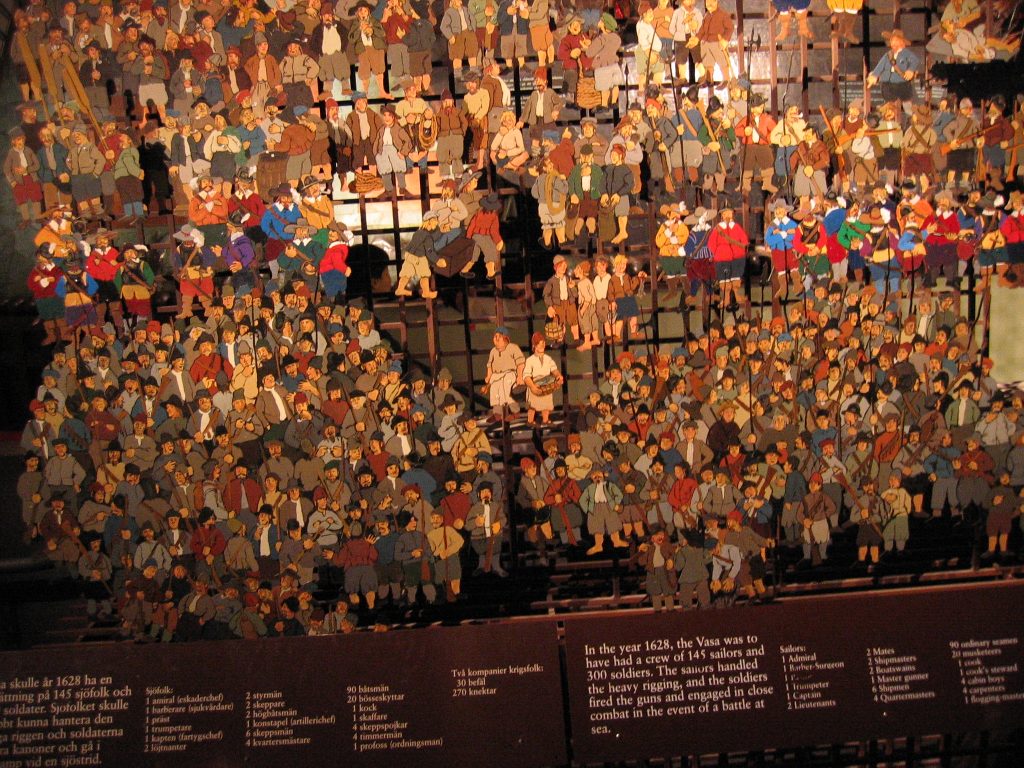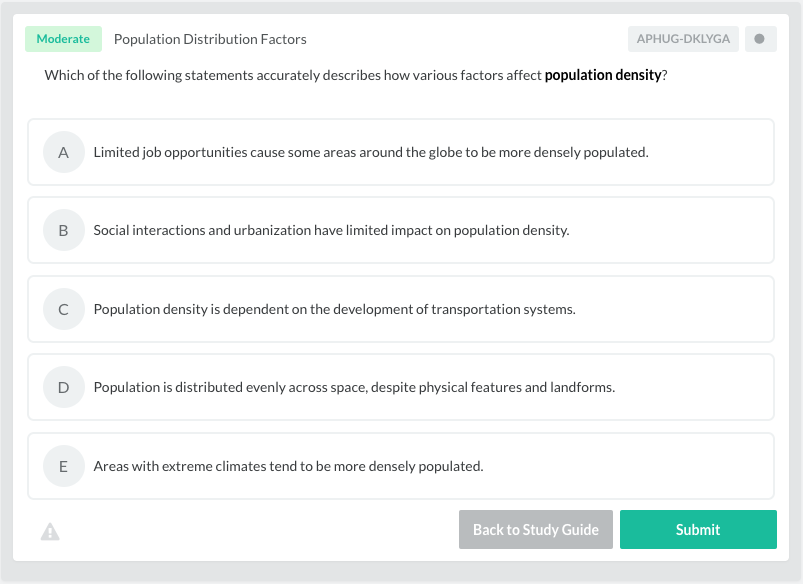Age Distribution Ap Human Geography Definition
Attention:This post was written a few years ago and may not reflect the latest changes in the AP® program. We are gradually updating these posts and will remove this disclaimer when this post is updated. Thank you for your patience!
Human populations have moved and settled in many locations over a long period of time. That movement or migration raises several questions for students of human geography. What makes up a population? How did the inhabitants get to live where they are today? What makes it grow or decline? In this AP® Human Geography study guide, we will define population distribution , and explore its influence on the settlement patterns of our planet.
It is important to know and be able to apply the concepts of population distribution at every scale from local to global. We will discuss population distribution as a way to explain the relationship between people and their environment. For the AP® Human Geography Exam, it is also important to know that human and physical factors influence population distribution.
What is Population Distribution?

We can define population distribution as the pattern of where people live. Population distribution is perhaps the most essential of all geographic expressions, because the ways in which people have organized themselves in space at any given time represent the sum of all of the advances they have made to their overall geographical area. Population distribution can also describe how people are arranged according to different variables such as age, sex, religion, or race.
World population distribution is uneven. Sparsely-populated regions are usually harsh places to live. These places usually have hostile environments; some examples are the Sahara Desert or Antarctica. Densely populated areas have more habitable environments – for instance, most of Europe.
When we talk about population and its characteristics, it is easy to confuse similar concepts. For example, you may confuse population distribution with population density . Population density is the number of people per unit of land area, whereas population distribution is the pattern of where the people live. When you study population distribution and density at the global level, they are both usually depicted graphically by how many people live in a square mile. When you study population at the local or regional level, you can get a better view of patterns in where people live and how they're distributed. There are three basic patterns of population distribution: they can equally-spaced apart (uniform dispersion), randomly spread out with no predictable pattern (random dispersion), or bunched in groups (clumped dispersion).
An example of population distribution is the fact that China's natural physical conditions resulted in uneven population distribution. There is a huge contrast in the number of people living in eastern China compared to the distribution in the western part of the country.
An example of population density would be that the in 2016, the population density of the United States was 91.5 people per square mile of land area.
What Factors Influence Population Distribution
There are numerous factors that explain why the population of the world has settled in locations that they inhabit today. These patterns of population distribution vary depending on the scale you are analyzing. You can study the distribution of a city or region, or you can look at the patterns from a global perspective. Factors that affect population distribution can be either be physical in nature or a by-product of the human condition.
These factors, however, operate not in a vacuum, but in concert with one another. It is impossible, then, to identify the influence of any one factor on population distribution. The relationship between these elements is not a simple one, and your job as a geographer is to explain how each of these factors plays into the abnormality of any population distribution.
What is Ecumene?
To understand why people live in the concentrations they do, you need to understand that only part of our planet is fit for human habitation. The habitable part is called the ecumene . Ecumene comes from an ancient Greek term for the "inhabited world". It refers to the part of the world that people have set up permanent residence in and use for agricultural and economic purposes. It is relatively small. In fact, about 75 percent of the population of the world live on 5 percent of the Earth's surface. Less than 30 percent of the earth's surface is land area, but large parts of that land cannot support any substantial number of inhabitants.
Some of the least habitable areas contain arid deserts, mountain ranges, and frigid tundras, but together, they cover nearly half of the land mass of our planet. Then take into consideration places where unproductive soil, persistent diseases, recurring droughts and other more localized conditions, keep population numbers comparatively low. Between these types of conditions, you can understand why the ecumene is relatively small.
Physical Factors that Influence Population Distribution
Physical factors affect population distribution because they limit where humans can establish permanent settlements. Some of those factors include altitude and latitude, land forms, climate, and soil condition.
High altitude, in general, restricts large permanent settlement because of the lack of oxygen. You will find very few settlements above 15,000 feet. In fact, 80 percent of the world's population live below altitudes around 1,500 feet.
Landforms also play a role in the distribution of population. Topography (the arrangement of natural and human-made physical features of an area) is one feature which affects human population growth. Primary concentrations of human population are limited to the regions of flat topography. Rugged terrain restricts the concentration of population in any area. You can see sudden changes in the population density on a world map of population distribution where plains meet mountain ranges.
River valleys may also promote human settlements. In Egypt, for example, 95 percent of the population is lives within five miles of the Nile River. This concentrated density along the Nile River is due to its pattern of cyclical irrigation, creating fertile soils. These fertile soils can support larger populations.
Climate arguably has the greatest influence on population distribution. Indirectly, climatic effects on soil, flora, and farming have bearings on the pattern of population distribution. Even though the most favorable climatic conditions are hard to determine, we do know that any extreme, such as in rainfall or temperature, will limit the number of people on any part of the planet.
The quality of the soil has an undeniable influence on population distribution. Fertile soils can support very dense populations, as evidenced by the large concentration of populations settled in river valleys and deltas. Conversely, poor-quality soils in temperate lands can support only a sparse population. It is important to note that climate also plays a part in the influence of soil of population distribution.
If you look at a map of the world depicting population distribution, you will see clusters of a vast number of people in areas of fertile and productive soils. This distribution is a result of thousands of years of communities remaining dependent on soils and pastures in their immediate vicinity. The large-scale, worldwide food transportation system of today is a newcomer, just over 200 years old. It is true that Romans imported grains from North Africa and colonial powers brought shiploads of goods across the oceans. However, the overwhelming majority of the world's peoples continued to survive on what the could cultivate locally. The result is the current clusters of population that you see on maps today.
Human Factors that Influence Population Distribution
Population distribution on the Earth's surface is not determined by physical elements alone, for within the broad framework of physical forces, human factors also influence the way population is distributed over our planet. These factors are economic, cultural, historical, and political.
Population distribution depends on the type and scale of economic activities. Technological and economic advancement brought about significant changes in population distribution of an area. In preindustrial agricultural societies, population distribution was evenly distributed, responding to the type of crops grown and their relationship to physical conditions.
The Industrial Revolution and the discovery of mineral sources have resulted in considerably changed population distributions in many parts of the world, with dense population concentrations replacing long-established pattern of dispersal and generally even distribution. Industrial growth creates job opportunities and attracts workers from outlying area to the industrial areas, almost invariably resulting in areas of high population densities.
Political events and government policies also cause redistribution of populations throughout human history. Civil wars in Africa have forced a significant number of people to migrate from one region to another and in postcolonial Africa, the wave of migration to urban area by rural dwellers looking for better jobs has resulted in massive changes in population patterns. If people are unsatisfied with their government's political system, they may pack up and leave that country to live in another.
Historical factors can also explain the patterns of population distribution. Past population distributions influence present and future population concentrations. The duration of settlements is important in determining the population density. Many of the areas with high population concentrations have a very long history of human habitation, while sparse populations in certain areas can, in part, be explained by recent habitation. You should not conclude, however, that the highest densities are always found in areas with the longest history of habitation.
Population Distribution and the AP® Human Geography Exam

We know that AP® Human Geography concepts like population may be hard to study for. But that's why we've created this AP® Human Geography crash course on population distribution, to bring those concepts into focus. The AP® Human Geography exam will test your knowledge of human population characteristics and the how population distribution is used to explain the relationship between population and the environment.
The CollegeBoard has not chosen an FRQ on the exam in recent years, but be prepared by using this study guide to broaden your understanding of population. You may be asked multiple-choice questions on what physical and human factors influence and explain population distribution. Make sure you keep population distribution and density straight. Distribution is the pattern of where the population lives; density is how many people live in a unit of land.
Conclusion
The study of population is important to anyone who is going to take the AP® Human Geography Exam. This AP® Human Geography crash course is here to help you understand what factors influence the distribution of the population on our planet. It is apparent that the factors that influence settlement patterns are varied and not clear-cut. To properly interpret them, you need to carefully analyze all the factors, both physical and human. You also need to study the past to understand how complex these forces are that affect our continued existence on earth.
You have learned that there are human and physical factors that affect population distribution and that none of these factors alone can explain the reason why people have settled in their present location on the Earth. But remember that population distribution is only one part of the study of geographic patterns and characteristics of human population. Make sure to check out our guides on other topics of AP® Human Geography .
Let's put everything into practice. Try this AP® Human Geography practice question:
Looking for more AP® Human Geography practice?
Check out our other articles on AP Human Geography.
You can also find thousands of practice questions on Albert.io. Albert.io lets you customize your learning experience to target practice where you need the most help. We'll give you challenging practice questions to help you achieve mastery in AP® Human Geography.
Start practicing here .
Are you a teacher or administrator interested in boosting AP® Human Geography student outcomes?
Learn more about our school licenses here.
Age Distribution Ap Human Geography Definition
Source: https://www.albert.io/blog/population-distribution-ap-human-geography-crash-course/

0 Response to "Age Distribution Ap Human Geography Definition"
Post a Comment